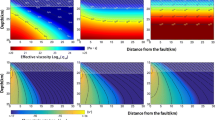Abstract
The laboratory tests of rock specimens show that transient creep, at which deformations increase with time whereas strain rate decreases occurs when creep strains are sufficiently small. Since plate tectonics only permits small deformations in the lithospheric plates, the creep of the lithosphere is transient (non-steady-state). In this work, we study how the rheology of the lithosphere that possesses elasticity, brittleness (pseudo-plasticity), and creep affects the folding in the Earth’s crust. Folding is caused by horizontal compression that results from the collision between the lithospheric plates. The effective viscosity characterizing the transient creep is lower than in the case of a steady-state creep and depends on the characteristic time of the considered process. The allowance for transient creep gives the distribution of the rheological properties of the horizontally compressed lithosphere in which the upper crust is brittle, whereas the lower crust and mantle lithosphere are dominated by transient creep. It is shown that the flows that arise in the lithosphere due to the instability under horizontal compression and cause folding are small-scale. These flows are concentrated in the upper brittle crust, they determine the short-wave Earth’s surface topography, penetrate into the lower, creep-dominated crust to a shallow depth, and do not penetrate into the mantle. Therefore, these flows do not deform the Moho.
Similar content being viewed by others
References
Berckhemer, H., Auer, F., and Drisler, J., High-temperature anelasticity and elasticity of mantle peridotite, Phys. Earth Planet. Inter., 1979, vol. 20, pp. 48–59.
Birger, B.I., Rheology of the Earth and thermoconvective mechanism for sedimentary basins formation, Geophys. J. Int., 1998, vol. 134, pp. 1–12.
Birger, B.I., Attenuation of seismic waves and the universal rheological model of the Earth’s mantle, Izv., Phys. Solid Earth, 2007, vol. 43, no. 8, pp. 635–641.
Birger, B.I., Transient creep and convective instability of the lithosphere, Geophys. J. Int., 2012, vol. 191, pp. 909–922.
Birger, B.I., Temperature-dependent transient creep and dynamics of cratonic lithosphere, Geophys. J. Int., 2013, vol. 195, pp. 695–705.
Burov, E. and Diament, M., The effective elastic thickness (Te) of continental lithosphere: what does it really mean?, J. Geophys. Res., 1995, vol. 100, pp. 3905–3927.
Byerlee, J.D., Brittle-ductile transition in rocks, J. Geophys. Res., 1968, vol. 73, pp. 4741–4750.
Karato, S. and Wu, P., Rheology of the upper mantle: a synthesis, Science, 1993, vol. 260, pp. 771–778.
Lambeck, K., The role of compressive forces in intracratonic basin formation and mid-plate orogenies, Geophys. Rev. Lett., 1983a, vol. 74, pp. 845–848.
Lambeck, K., Structure and evolution of the intracratonic basins of Central Australia, Geophys. J. R. Astron. Soc., 1983b, vol. 74, pp. 843–886.
Martinod, J. and Davy, P., Periodic instabilities during compression or extension of the lithosphere: 1. Deformation models from an analytical perturbation method, J. Geophys. Res., 1992, vol. 97, pp. 1999–2014.
Moresi, L. and Solomatov, V., Mantle convection with a brittle lithosphere: thoughts on the global tectonic styles of the Earth and Venus, Geophys. J. Int., 1998, vol. 133, pp. 669–682.
Ricard, Y. and Froidevaux, C., Stretching instabilities and lithospheric boudinage, J. Geophys. Res., 1986, vol. 91, pp. 8314–8324.
Smith, R.B., Formation of folds, boudinage, and mullions in non-Newtonian materials, Geol. Soc. Am. Bull., 1977, vol. 88, pp. 312–320.
Smith, R.B., The folding of a strongly non-Newtonian layer, Am. J. Sci., 1979, vol. 279, pp. 272–287.
Turcotte, D. and Shubert, G., Geodynamics: Applications of Continuum Physics to Geological Problems, New York: Wiley, 1982.
Zuber, M.T., Parmentier, E.M., and Fletcher, R.C., Extension of continental lithosphere: a model for two scales of basin and range deformation, J. Geophys. Res., 1986, vol. 91, pp. 4826–4838.
Author information
Authors and Affiliations
Corresponding author
Additional information
Original Russian Text © B.I. Birger, 2015, published in Fizika Zemli, 2015, No. 3, pp. 122–133.
Rights and permissions
About this article
Cite this article
Birger, B.I. Rheology of the lithosphere and the folding caused by horizontal compression. Izv., Phys. Solid Earth 51, 437–447 (2015). https://doi.org/10.1134/S1069351315020020
Received:
Accepted:
Published:
Issue Date:
DOI: https://doi.org/10.1134/S1069351315020020



